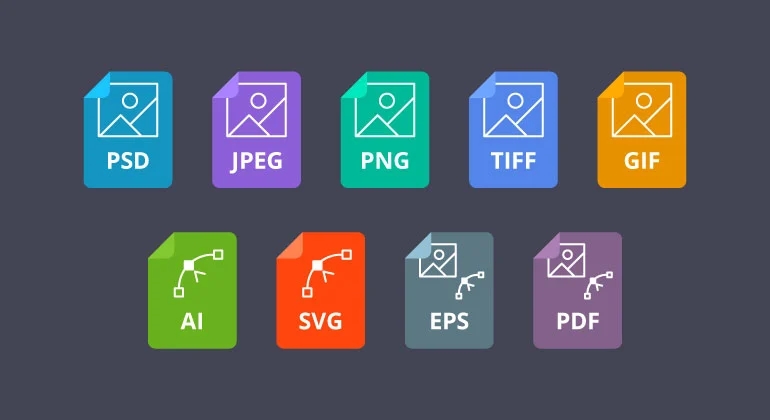- What is a File Type?: A file type, also known as a file format, defines how data is structured and stored within a file. It determines how the content is represented and how software applications interpret and handle that content.
- Importance of File Types: File types are essential for compatibility and efficient data processing. Different file types are optimized for specific types of data, and using the right format ensures that your files are correctly interpreted by the appropriate software.
- File Extensions and Formats: File extensions are typically three or four-letter codes appended to the end of a filename, indicating the file’s format. For instance, “.docx” indicates a Word document. Formats encompass a wider definition of how data is organized and stored.
2. Document File Types
- DOCX and ODT (Word Processing): DOCX is a Microsoft Word document format, while ODT is the Open Document Text format used by open-source word processors like LibreOffice. They store text, images, formatting, and more.
- PDF (Portable Document Format): PDF is a versatile format for sharing documents that preserves formatting across different devices and platforms. It’s widely used for eBooks, forms, and manuals.
- XLSX and CSV (Spreadsheets): XLSX is the Microsoft Excel spreadsheet format, while CSV (Comma-Separated Values) is a plain text format used for tabular data. XLSX supports more complex data and formatting.
- PPTX and ODP (Presentations): PPTX is the PowerPoint presentation format, and ODP is the Open Document Presentation format. They store slides, images, animations, and transitions.
3. Image File Types
- JPEG and JPG: JPEG (Joint Photographic Experts Group) is a widely used lossy compression format for photographs. JPG is the common file extension for JPEG images.
- PNG (Portable Network Graphics): PNG is a lossless image format that supports transparency and is suitable for images with sharp edges, such as logos and graphics.
- GIF (Graphics Interchange Format): GIF is known for its support of animations and basic transparency. It uses lossless compression but is limited in color depth.
- TIFF (Tagged Image File Format): TIFF is a high-quality image format used for storing detailed images, often in professional settings like printing and publishing.
- BMP (Bitmap): BMP is an uncompressed image format that stores data pixel by pixel. It’s rarely used due to its large file sizes.
4. Audio File Types
- MP3 (MPEG Audio Layer III): MP3 is a compressed audio format that balances sound quality and file size, making it ideal for music and audio podcasts.
- WAV (Waveform Audio File Format): WAV is a lossless audio format known for its high quality but larger file sizes. It’s often used for professional audio production.
- FLAC (Free Lossless Audio Codec): FLAC is a lossless audio format that retains original audio quality while achieving smaller file sizes compared to WAV.
- AAC (Advanced Audio Coding): AAC is a compressed audio format that offers improved quality over MP3 at similar bit rates. It’s commonly used for music streaming.
5. Video File Types
- MP4 (MPEG-4 Part 14): MP4 is a widely supported video format that uses compression to balance quality and file size. It’s used for online streaming and video sharing.
- AVI (Audio Video Interleave): AVI is an older video format that offers good quality but larger file sizes compared to more modern formats.
- MKV (Matroska Video): MKV is a versatile format that supports various audio, video, and subtitle streams within a single file.
- MOV (QuickTime Movie): MOV is the Apple QuickTime video format, commonly used for high-quality videos and movie trailers.
6. Compressed File Types
- ZIP and RAR: ZIP and RAR are archive formats used to compress multiple files and folders into a single file, reducing storage space and facilitating easier sharing.
- 7Z (7-Zip): 7Z is an open-source compressed archive format known for its high compression ratio and strong encryption capabilities.
- TAR (Tape Archive): TAR is a file packaging format often used in Unix-like systems. It combines multiple files into a single archive but does not compress them.
7. Executable File Types
- EXE (Executable): EXE files contain computer programs or software applications that can be run by the operating system when executed.
- DMG (Disk Image): DMG is a disk image format used on macOS to distribute software and files. It can contain applications, documents, or installation files.
- APK (Android Package): APK is the file format used for Android app installation. It contains all the resources and code needed for the app to run.
8. Web File Types
- HTML (Hypertext Markup Language): HTML is the backbone of web pages, providing structure and content through tags that define elements like headings, paragraphs, and links.
- CSS (Cascading Style Sheets): CSS is used to control the visual appearance and layout of HTML elements on a web page.
- JS (JavaScript): JS is a scripting language that adds interactivity and dynamic behavior to web pages, enabling actions like form validation and animations.
- PHP (Hypertext Preprocessor): PHP is a server-side scripting language used for creating dynamic web pages and web applications.
9. Database File Types
- DB (Database): DB files often refer to generic database files that store structured data in a tabular format, used by various database management systems.
- SQL (Structured Query Language): SQL is a language used to manage and manipulate relational databases, enabling tasks like data retrieval, insertion, and updates.
- MDB and ACCDB (Microsoft Access): MDB and ACCDB are file formats used by Microsoft Access to store database information, including tables, queries, forms, and reports.
10. Miscellaneous File Types
- Torrent Files: Torrent files are used to initiate and manage peer-to-peer (P2P) file sharing through torrent clients.
- Font Files (TTF, OTF): Font files contain typeface information used for rendering text. TTF and OTF are common font formats.
- CAD Files (DWG, DXF): CAD files are used in computer-aided design software. DWG and DXF are common formats for storing 2D and 3D design data.
- GIS Files (Shapefile, GeoJSON): Geographic Information System (GIS) files store geospatial data. Shapefile and GeoJSON are formats for representing geographic features and attributes.
11. Font Files
- OTF (OpenType Font): OTF is a font format that supports advanced typographic features like ligatures, alternate characters, and multiple language support. It’s widely used for print and digital design.
- TTF (TrueType Font): TTF is a popular font format known for its simplicity and broad compatibility. It’s used for both screen and print applications.
12. Video Game File Types
- SWF (Shockwave Flash): SWF is a multimedia format used for interactive content, animations, and games on the web. It was widely used for browser-based games and animations.
- UNITY3D (Unity Game Engine): UNITY3D files are created by the Unity game engine. They contain 3D models, textures, scripts, and other assets used to build games and interactive experiences.
13. 3D Model File Types
- OBJ (Wavefront OBJ): OBJ is a widely used 3D model format that stores geometry, texture coordinates, and material information. It’s compatible with many 3D software applications.
- STL (Stereolithography): STL is a format used for 3D printing. It represents the surface geometry of a 3D object using triangles.
14. CAD File Types
- DWG (AutoCAD Drawing): DWG is a proprietary file format used by AutoCAD and other CAD software for storing 2D and 3D design data, including geometry, annotations, and metadata.
- DXF (Drawing Exchange Format): DXF is a file format used to exchange CAD data between different software applications. It supports various types of geometric and non-geometric data.
15. GIS File Types
- Shapefile: A shapefile is a popular geospatial vector data format used in GIS software. It stores geographic features like points, lines, and polygons along with attribute data.
- GeoJSON (Geographic JSON): GeoJSON is a format for encoding a variety of geographic data structures using JSON. It’s commonly used for web mapping and spatial data exchange.
16. Backup File Types
- BAK (Backup): BAK files are created as backup copies of other files, providing a safety net in case the original file is lost or corrupted. The format varies based on the software used.
17. Virtual Machine File Types
- VMDK (Virtual Machine Disk): VMDK is a file format used by VMware virtualization software to store virtual machine disk images, including the operating system and data.
- VDI (VirtualBox Disk Image): VDI is the file format used by Oracle VirtualBox for storing virtual machine disk images.
18. Document Markup Languages
- XML (eXtensible Markup Language): XML is a versatile markup language used to store and transport structured data. It’s used for configuration files, data exchange, and more.
- JSON (JavaScript Object Notation): JSON is a lightweight data interchange format that’s easy for humans to read and write, and easy for machines to parse and generate.
19. EBook File Types
- EPUB (Electronic Publication): EPUB is a standard format for eBooks. It supports reflowable content, making it adaptable to different screen sizes, fonts, and orientations.
- MOBI (Mobipocket): MOBI is used for Amazon Kindle eBooks. It supports features like bookmarks, notes, and highlights.
20. Archive File Types
- GZ (Gzip Compressed File): GZ is a compression format often used on Unix-like systems. It compresses a single file, but doesn’t bundle multiple files together like an archive.
- TAR.GZ (Tarball with Gzip Compression): TAR.GZ combines files into a single archive and then compresses the archive using Gzip, commonly used for software distribution on Linux.
21. Project File Types
- PRJ (Project): PRJ files are used to store project-specific settings, configurations, and metadata related to a software project. The format varies based on the software being used.


Leave a comment